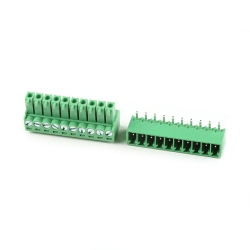10-Way Terminal & Socket
PRT-22461
10-Way Terminal & Socket
SKU: PRT-22461
$2.60
In stock
SKU
PRT-22461
A rugged 10-way 3.5mm-pitch PCB terminal block & 3.5mm-pitch rising clamp screw socket.
Product Overview
This is a rugged 10-way 3.5mm-pitch PCB terminal block & 3.5mm-pitch rising clamp screw socket. Ideal for robust I/O and power connections when paired together.
Includes:
- 1x 10-way 3.5mm Rising Clamp Screw Socket
- 1x 10-way 3.5mm 90° Terminal Block
Hookup Accessories
Features & Specs
10-way 3.5mm 90° Terminal Block:
- 10-way
- 3.5mm pitch
- Current Rating: 12 Amp/Way Max.
- Voltage Rating: 300V AC
- Withstand Voltage: 2500V AC for 1 minute
- Operation Temperature: -40°C ~ +105°C
- Soldering Reliability: 250°C +/- 10°C
- 5 Seconds Max.
- Insulator Body: Polyamide+G.F.(UL94V-0), Green
- Solder Pin: Copper Alloy, Tin Plated
- RoHS Compliant
10-way 3.5mm Rising Clamp Screw Socket:
- 10-way
- 3.5mm pitch
- Voltage Rating: 300V AC
- Current Rating: 12 Amp/Way Max.
- Withstand Voltage: 2500V AC for 1 minute
- Wire Range: 16 ~ 24 AWG
- Operation Temperature: -40°C ~ +105°C
- Insulator Body: Polyamide+G.F.(UL94V-0), Green
- Contact: Copper Alloy, Tin Plated
- Terminal Screw: Steel, Galvanized With Cr3+ Plated
- RoHS Compliant
Customer Reviews

10-Way Terminal & Socket
$2.60
PRT-22461
Stock and Customer Discounts
$2.6 retail price.
Available Discounts
- $2.47 | 25+ units
- $2.34 | 100+ units






